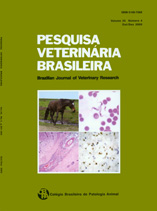 |
|
|
|
Year 2005 - Volume 25, Number 4
|

|
Surtos de tripanossomíase por Trypanosoma evansi em eqüinos no Rio Grande do Sul: aspectos epidemiológicos, clínicos, hematológicos e patológicos, p.239-249
|
Rodrigues A., Fighera R.A., Souza T.M., Schild A.L., Soares M.P., Milano J. & Barros C.S.L. 2005. [Outbreaks of trypanosomiasis in horses by Trypanosoma evansi in the state of Rio Grande do Sul, Brazil: epidemiological, clinical, hematological, and pathological aspects.] Surtos de tripanossomíase por Trypanosoma evansi em eqüinos no Rio Grande do Sul: aspectos epidemiológicos, clínicos, hematológicos e patológicos. Pesquisa Veterinária Brasileira 25(4):239-249. Depto Patologia, Universidade Federal de Santa Maria, 97105-900 Santa Maria, RS, Brazil. E-mail: claudioslbarros@uol.com.br
Cases of trypanosomiasis by Trypanosoma evansi were diagnosed in horses in the state of Rio Grande do Sul, Brazil, between 2003 and 2004. In one stud farm (Farm A) with 125 horses, 52 died. Additionally, around 80 mares were sent to Farm A to be bred. Of those, 66 became ill and 56 died after being returned to their farms of origin. Twenty one horses clinically affected by the disease were observed. Clinical signs included loss of weight (despite voracious appetite), lethargy, incoordination and instability of hindlimbs, atrophy of the large muscles of the hindlimbs, muscle weakness and paleness of mucosae. Specimens of T. evansi were detected in the blood drawn from four affected horses. Normocytic normochromic anemia with PCVs ranging from 15 to 31%, leucocytosis due to lymphocytosis associated to large atypical lymphocytes was observed in several affected horses. High levels of antibodies against T. evansi were detected in the serum of six horses from Farm A. Eight horses presented encephalic neurological signs such as circling, ataxia, blindness, excitation, falls, listlessness, proprioception deficits and head tilt. One horse assumed a “dog-seating position”. Necropsy findings included muscle atrophy, enlargement and lymphoid hyperplasia of the spleen and lymphnodes, edema and softening of the white and grey matter of the brain. Histologically, an overwhelming necrotizing panencephalitis was observed in the seven horses with encephalic signs. This panencephalitis was characterized by marked edema, demyelination and necrosis and perivascular infiltrates of 6-10 layers of lymphocytes and plasm cells affecting both the white and gray matter. Several plasm cells in the inflammatory infiltrate contained numerous eosinophilic globules in their cytoplasm (Mott cells). Similar histological lesions were observed in the spinal cord of the horse with the “dog-seating position”. The brains of five horses with the encephalic signs were submitted to immunohistochemistry stain by the streptavidin-biotin technique. In all of those five brains moderate to abundant specimens of T. evansi in the perivascular spaces and neuropile were marked by the specific antibody. Epidemiological, clinical, hematological, and pathological aspects of equine trypanosomiasis caused by T. evansi are discussed. |
| |
|
|
| |
|
 |